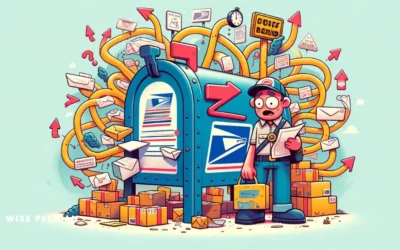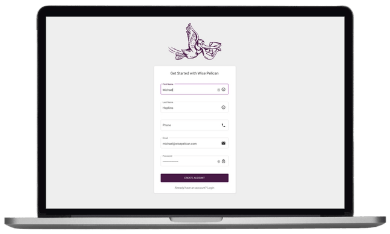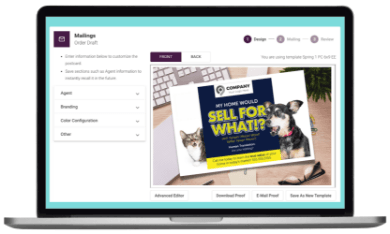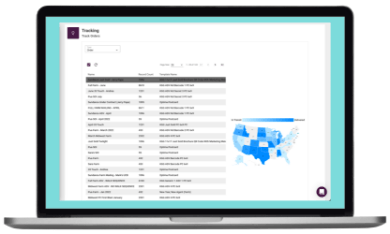We have included our YouTube video explaining USPS EDDM and the mistakes you may be making in your real estate marketing efforts.
Every Door Direct Mail (EDDM) is a term frequently used in real estate marketing. USPS EDDM is a powerful tool, but it can be complex and confusing, particularly for real estate agents seeking to utilize its potential. This extensive guide explains how EDDM works and why there are better choices in real estate marketing.

USPS EDDM Unveiled
Every Door Direct Mail is a direct mail marketing strategy offered by the United States Postal Service (USPS). It presents a unique opportunity for businesses and organizations to reach their target audience without needing specific recipient addresses.
Instead, you select a USPS carrier route, and USPS ensures that your marketing materials find their way into every mailbox on that route.
The ABCs of USPS Carrier Routes
At the heart of EDDM is the concept of USPS carrier routes. These routes are geographic areas serviced by USPS mail carriers during daily rounds.
When executing an EDDM campaign, you can handpick one or more carrier routes that align with your campaign objectives and budget. USPS provides valuable tools and resources to assist you in this crucial selection process.
Preparing Your Mail Pieces for USPS
With your chosen carrier routes in mind, the next step is preparing your mail pieces according to USPS guidelines. It’s imperative to adhere to these guidelines, which dictate the size, weight, and format of EDDM mail pieces.
The Cost of EDDM
One essential aspect to understand is that USPS EDDM entails paying for postage based on the number of mail pieces you distribute and the selected carrier routes.
Regardless of whether homes on your route are vacant or absentee-owned, USPS charges you for each address on the route. This includes instances where USPS won’t deliver to vacant homes—a crucial agreement that you need to be aware of when evaluating EDDM costs.
The Cost Structure of EDDM: A Closer Look
Every Door Direct Mail is known for its cost-effective approach to reaching a broad audience within specific geographic areas. However, the cost structure of EDDM can be unique, and understanding it is key to managing your campaign budget effectively.
In a traditional direct mail campaign, you typically pay for postage based on the number of pieces you’re sending and the specific addresses to which you deliver. Each address incurs postage costs. However, EDDM takes a different approach:
Paying Per Piece With USPS EDDM
With EDDM, you pay for each mail piece you intend to distribute. This means that whether you’re sending postcards, letters, brochures, or any other type of marketing material, the number of individual pieces you have printed determines your postage cost.
Selecting USPS Carrier Routes
The other crucial factor in EDDM postage costs is the selection of USPS carrier routes. Instead of specifying individual addresses, choose one or more carrier routes based on your campaign objectives. USPS offers tools and resources to help you identify suitable routes.
Understanding the Key Agreement: Paying for All Addresses
Now, here’s where the agreement between businesses and USPS becomes pivotal. Regardless of whether the homes on your chosen carrier route are vacant, absentee-owned, or owner-occupied, USPS charges you for every address on that route.
Consider a hypothetical scenario where you decide to target a carrier route that includes 500 homes. Even if a portion of those homes is vacant or absentee-owned—meaning USPS will not deliver to those addresses—you’re still responsible for the postage costs associated with all 500 addresses. USPS does not differentiate between deliverable and undeliverable addresses in terms of charging.

Why USPS Charges for All Addresses
This approach may seem counterintuitive or even unfair, especially when you know that USPS won’t deliver to specific homes. However, it’s essential to grasp the rationale behind this system:
Administrative Efficiency
USPS EDDM was designed to simplify the direct mail process, particularly for small businesses and local marketers. Charging per piece and delivering to entire carrier routes streamlines administration and reduces addressing complexity.
Predictable Pricing
USPS charges a fixed rate per piece based on the size and format of your mailer, making it easier for businesses to predict their postage costs and budget accordingly.
Fostering Equal Access
By charging for all addresses on a carrier route, USPS ensures that the EDDM program remains accessible and doesn’t discriminate against certain types of addresses or properties.
Encouraging Comprehensive Campaigns
The approach USPS uses encourages businesses to reach as many potential customers as possible within a chosen geographic area, which aligns with the program’s goal of broad, local reach.
Evaluating EDDM Costs Effectively
Understanding that EDDM charges for all addresses, even if they are vacant or absentee-owned, is crucial when evaluating the cost-effectiveness of your campaign.
To make informed decisions about whether EDDM is the right choice for your specific marketing goals, consider the following:
Carrier Route Selection
Be strategic when choosing carrier routes. Focus on areas with a higher density of potential customers to maximize the return on your investment.
Budgeting
Account for the fact that you’ll be charged for all addresses on your chosen routes. Ensure your budget can accommodate this cost structure.
ROI Assessment
Evaluating your EDDM campaign based on its return on investment is essential. Consider the potential returns from reaching a broad audience within a geographic area versus the costs incurred. When you’re mailing just sold postcards or just listed postcards you’re mainly mailing these to attract listings. If you reach the tenant instead of the homeowner you’re drastically reducing your potential return on investment from your mailing campaign.
Understanding the postage cost structure and the agreement between businesses and USPS in EDDM is vital for making well-informed marketing decisions.
While EDDM offers unique advantages, including its cost-efficiency and broad reach, it’s essential to factor in the postage costs associated with all addresses on your selected carrier routes when evaluating the suitability of EDDM for your campaign.
EDDM’s Delivery Approach
A fundamental distinction of EDDM is that it delivers mail pieces to property addresses rather than individual homeowners.
This means that your marketing materials are received by property occupants, not necessarily the property owners. The implications of this approach become evident when considering your campaign’s goals.
The Property Address vs. Individual Homeowners
In traditional direct mail campaigns, marketers typically aim to reach specific individuals, often homeowners, by addressing their marketing materials directly to them. This personalized approach allows for tailored messaging and a more direct connection with the intended recipient.
However, EDDM takes a different route. When you opt for EDDM, your mail pieces are not addressed to individual homeowners but to the property address itself. This means that the materials you send will be received by anyone currently occupying the property, including tenants, guests, and property owners.
Implications for Your Marketing Campaign
Understanding the implications of EDDM’s property-address-based approach is crucial for aligning your campaign with your objectives and target audience:
Broad Audience Reach
EDDM’s property-address-centric approach is excellent for reaching a broad audience within a specific geographic area. It ensures that your marketing materials are distributed to every property on your selected carrier route, providing maximum exposure.
Limited Personalization
Personalized messaging becomes more challenging because your materials are not addressed to individual homeowners. Instead of tailoring your content to a specific recipient, you must craft your message with a broader audience in mind.
Message Alignment
The success of your EDDM campaign depends on how well your message resonates with property occupants, not just property owners. This is a critical consideration when determining the goals of your campaign.

When EDDM Makes Sense
To make the most of EDDM, it’s essential to consider when this approach aligns with your campaign’s goals.
Targeting Potential Buyers
If your primary objective is to target potential buyers within a specific neighborhood, EDDM can be effective. For instance, if you’re a real estate agent looking to solicit buyers for properties in a particular area, delivering marketing materials to property occupants can help you reach your target audience.
Community-Wide Promotions
EDDM is valuable when promoting community-wide events, services, or offers. It’s an excellent way to engage with the entire community, such as advertising a local restaurant opening or a neighborhood garage sale.
Local Brand Awareness
If you aim to establish a strong local presence and raise brand awareness within a geographic region, EDDM allows you to achieve widespread exposure.
When EDDM May Not Be Ideal
Conversely, there may be better choices than EDDM for all marketing objectives.
Securing Real Estate Listings
If your primary aim is to secure real estate listings, EDDM may not align with your goals as effectively. In this case, you’ll likely want to target homeowners, not just property occupants, to convey your message about selling their homes.
Highly Personalized Campaigns
EDDM is not well-suited for highly personalized marketing campaigns that require tailored messaging for specific individuals. Consider alternative marketing strategies if your campaign relies on customized content.
Niche Audience Targeting
A more precise list-based direct mail campaign might be better if your target audience is highly specific and needs to be aligned with the entire carrier route.
The distinction between EDDM’s property-address-based approach and traditional direct mail’s individual homeowner focus can significantly impact the effectiveness of your marketing campaign.
When considering EDDM, it’s crucial to assess whether its broad audience reach and property-occupant-centric approach align with your campaign’s goals and messaging strategy. Doing so lets you decide when and how to leverage EDDM in your marketing efforts.
Pros of EDDM
- Cost-Efficiency: EDDM can be cost-effective, mainly when targeting large geographic areas.
- Local Precision: It’s an excellent choice for real estate agents seeking a local presence.
- Extensive Reach: EDDM reaches every address on your chosen carrier route, maximizing your visibility.
Cons of EDDM
- Limited Targeting: EDDM doesn’t allow precise targeting of homeowners as it reaches occupants.
- Vacant Home Costs: You pay for postage even for vacant or absentee-owned properties.
- Alignment with Goals: If you aim to secure real estate listings, there may be more effective choices than EDDM.

Shifting Focus to ROI
In the dynamic realm of real estate marketing, your primary concern should transcend the cost of your campaign. Instead, focus on return on investment (ROI), a metric that quantifies the effectiveness of your marketing endeavors in terms of revenue generated. When assessing the success of your direct mail campaign, ROI should be your guiding star.
Return on Investment is a powerful and universal metric used across various industries to evaluate the effectiveness and profitability of investments, including marketing campaigns. In real estate marketing, ROI serves as the ultimate benchmark for assessing the success of your efforts. Here’s why it should be your guiding star:
Financial Accountability
ROI provides a clear and objective way to measure the financial impact of your marketing campaigns. It helps you answer the fundamental question: “Is my marketing generating a positive return or not?”
Bottom-Line Focus
While it’s essential to manage your marketing budget efficiently, the ultimate goal of any marketing campaign is to contribute to your bottom line by generating revenue. ROI shifts the focus from spending to earning and helps you gauge the financial value of your marketing endeavors.
Comprehensive Assessment
ROI considers the costs associated with your marketing campaign (e.g., printing, postage, design, distribution) and the revenue it generates. This comprehensive assessment lets you see the complete picture of your campaign’s impact on your business.
Informed Decision-Making
When ROI is your guiding star, you make decisions based on data and results rather than assumptions or emotions. It empowers you to allocate resources more effectively and invest in strategies that deliver the best returns.
Calculating ROI in Real Estate Marketing
Calculating ROI for your real estate marketing campaigns involves a straightforward formula:
ROI = (Net Profit – Marketing Costs) / Marketing Costs
Here’s a breakdown of the critical components:
- Net Profit: This includes all the revenue generated directly from your marketing efforts. For a real estate agent, it might consist of commissions from property sales or fees from client acquisitions.
- Marketing Costs: This encompasses all the expenses associated with your marketing campaign, such as printing, postage, design, and any other related costs.
Why ROI Should Guide Your Real Estate Marketing Strategy
ROI allows you to assess the efficiency of different marketing channels and tactics. Tracking ROI over time allows you to identify which strategies deliver the best results and allocate resources accordingly.
Campaign Optimization
When ROI is your primary concern, you’re motivated to optimize your marketing campaigns continually. To maximize your return, you can experiment with different messaging, targeting strategies, and creative elements.
Budget Allocation
ROI helps you make data-driven decisions about where to allocate your marketing budget. You can focus your resources on strategies that consistently generate a positive ROI and reduce investment in less effective approaches.
Long-Term Growth
By prioritizing ROI, you’re not just looking for short-term wins. You’re building a sustainable and profitable marketing strategy that can contribute to your real estate business’s long-term growth and success.
Adaptation and Agility
Real estate markets can change rapidly. Prioritizing ROI encourages you to stay agile and adapt to market shifts. You can adjust your marketing strategies to maintain a positive ROI in response to changing conditions.
Return on Investment is essential for making informed decisions and achieving sustainable success. ROI serves as a financial compass, guiding you toward strategies that maximize revenue and profitability while helping you maintain financial accountability and adapt to evolving market conditions. By keeping ROI as your guiding star, you’re better equipped to thrive in the competitive world of real estate marketing.
Understanding Absentee Owners
In simple terms, absentee owners are property owners who don’t reside in their homes. These individuals constitute a goldmine for real estate agents aiming to secure listings. Why? Because absentee owners typically have a higher turnover rate, indicating they’re more likely to sell their properties.
The Goldmine for Real Estate Agents
Why are absentee owners often referred to as a goldmine for real estate agents? Several key factors contribute to their desirability as potential clients.
Higher Turnover Rate
One of the primary reasons real estate agents covet absentee owners is their tendency to have a higher turnover rate than owner-occupied homes.
This means absentee owners are likelier to sell their properties relatively quickly. The reasons for selling may vary, but they often include investment objectives, changing life circumstances, or a desire to cash in on their property.
Motivated Sellers
Absentee owners may be more motivated to sell, especially those who live far from their properties. Managing a property from a distance can be challenging and may lead owners to consider selling as a solution. This motivation can translate into a quicker and more straightforward sales process.
Potential for Multiple Listings
Absentee owners who own multiple properties can offer real estate agents the opportunity for multiple listings. If an absentee owner has a portfolio of properties, a successful transaction with one property can lead to additional listings within the same portfolio.
Reduced Emotional Attachment
Absentee owners often have a more pragmatic and less emotional connection to their properties. This can make negotiations smoother and less emotionally charged, facilitating sales.
Increased Likelihood of Hiring a Real Estate Agent
Managing a property from a distance can be logistically challenging. Absentee owners are more likely to seek the assistance of a local real estate agent who can handle the intricacies of the sale on their behalf. This allows real estate agents to offer their expertise and services.
Potential for Referrals
Satisfying absentee owner clients can lead to referrals, especially if they have a network of fellow absentee owners or investors. Word-of-mouth referrals can expand an agent’s client base further.
Less Competition
While absentee owners can be lucrative clients, they may not be the primary focus of all real estate agents. This means there’s potentially less competition for their business compared to owner-occupied homeowners.

Targeting Absentee Owners
Real estate agents who wish to tap into the goldmine of absentee owners can employ several strategies. Let’s look at a few of them.
- List Segmentation: Utilize real estate databases and resources to identify absentee owners in your target areas. Segment your marketing efforts to reach out specifically to this group.
- Tailored Messaging: Create marketing materials and messages that address absentee owners’ unique needs and motivations. Highlight how your services can make their long-distance property management more seamless.
- Local Expertise: Emphasize your local expertise, as absentee owners often rely on the knowledge of a trusted local agent to navigate the market effectively.
Absentee owners represent a valuable opportunity for real estate agents seeking to secure listings. Their higher turnover rate, motivation to sell, and potential for multiple listings make them a goldmine within the real estate market. By understanding their unique needs and crafting tailored marketing strategies, real estate agents can position themselves to tap into this lucrative client base successfully.
The Importance of Reduced Competition
In the highly competitive real estate market, finding ways to stand out and secure listings is essential for success. One valuable strategy is to target absentee owners, who often offer a less crowded playing field for real estate agents.
The reduced competition when marketing to absentee owners can be attributed to the fact that they are less likely to have local friends or family members who are real estate agents. Here’s why this matters.
Limited Existing Connections
Absentee owners, by definition, do not live near their investment properties. As a result, they may have yet to establish local connections, especially within the real estate industry. Unlike owner-occupied homeowners who might have personal relationships with local agents, absentee owners often lack these preexisting connections.
Objective Decision-Making
When property owners have friends or family members who are real estate agents in the same area, personal relationships can sometimes influence their decisions. They may feel obligated to work with someone they know, even if there are more advantageous choices for their specific real estate needs. On the other hand, absent owners are more likely to make decisions based purely on their property’s financial and logistical considerations.
Level Playing Field
The absence of personal connections in the local real estate market levels the playing field for agents looking to secure listings from absentee owners. Real estate agents can compete based on their professional qualifications, expertise, and the quality of their services rather than relying on personal connections.
Opportunity for Building New Relationships
Real estate agents targeting absentee owners have the opportunity to build new, professional relationships. This can be achieved by demonstrating local market knowledge, providing excellent service, and showcasing expertise in managing long-distance transactions. Building trust with absentee owners can result in ongoing business relationships and referrals.
Strategies for Marketing to Absentee Owners
Real estate agents can employ several strategies to capitalize on the reduced competition when marketing to absentee owners.
Tailored Marketing
Craft marketing materials and messages that specifically address absentee owners’ unique needs and concerns. Highlight your ability to manage their properties effectively from a distance and provide peace of mind.
Local Expertise
Emphasize your deep knowledge of the local real estate market. This expertise can appeal to absentee owners who rely on your understanding of the area.
Professionalism
Position yourself as a trusted professional who can offer objective advice and assistance. Stress the importance of impartiality in helping absentee owners make informed decisions.
Networking
Attend local real estate events, join professional organizations, and build a robust network within the real estate industry to expand your reach and credibility among absentee owners.
The reduced competition when marketing to absentee owners, due to their lower likelihood of having local friends or family members who are real estate agents, presents a significant opportunity for real estate professionals.
By recognizing this advantage and tailoring their approach to address the specific needs of absentee owners, real estate agents can position themselves as valuable partners in managing and selling investment properties, ultimately securing more listings and building lasting professional relationships.
Choosing the Right Approach
Ultimately, the choice between EDDM and traditional list-based campaigns hinges on your specific goals as a real estate agent. If your primary objective is to reach property occupants, particularly in apartment buildings or particular neighborhoods, EDDM can make sense.
Understanding the Choice: EDDM vs. List-Based Campaigns
As a real estate agent, selecting the right marketing strategy is critical to achieving your objectives effectively. Your specific goals and target audience should drive the choice between EDDM and list-based campaigns. Let’s take a closer look at this decision-making process.
EDDM: Targeting Property Occupants
Every Door Direct Mail (EDDM) is a powerful tool for reaching a broad audience, particularly property occupants. EDDM enables you to deliver marketing materials to every address within selected carrier routes, making it an ideal choice when your primary objective is to engage property occupants. Here are some scenarios where EDDM makes sense:
Large Apartment Buildings
If you’re focusing on marketing to renters or potential buyers in large apartment complexes, EDDM can be highly effective. Since EDDM delivers to property addresses, it ensures that your message reaches all residents, regardless of whether they own or rent.
Specific Neighborhoods
EDDM can be helpful when targeting specific neighborhoods or areas with a high concentration of potential clients. It allows you to saturate the area with your marketing materials, increasing your visibility within the community.
Community-Wide Promotions
When promoting community-wide events, such as open houses, local initiatives, or real estate services, EDDM is a valuable tool for reaching all residents and generating local buzz.
List-Based Campaigns: Precision and Personalization
On the other hand, traditional list-based campaigns involve targeting specific individuals or households based on criteria such as demographics, buying behavior, or property ownership. List-based campaigns offer a higher degree of precision and personalization.
Securing Real Estate Listings
If your primary goal is to secure real estate listings from property owners, especially those with specific characteristics (e.g., certain property types and equity levels), list-based campaigns provide the precision needed to identify and engage these homeowners.

Highly Personalized Messaging
List-based campaigns excel in delivering highly personalized messages to specific individuals or households. This is valuable when tailoring your marketing materials to unique needs and motivations.
Niche Audience Targeting
When your target audience is specific and not defined solely by geographic location, list-based campaigns allow you to focus your efforts on reaching the right people.
Balancing Goals and Strategies
Ultimately, the choice between EDDM and list-based campaigns should align with your specific goals and the characteristics of your target audience. Consider the following when making this decision.
Campaign Objectives
Clearly define your objectives: securing listings, reaching property occupants, promoting local events, or building brand awareness.
Target Audience
Understand your ideal client profile. Are you looking to engage property owners or property occupants? Does your target audience span specific geographic areas or specific demographic criteria?
Budget and Resources
Assess your budget and available resources. EDDM can be cost-effective for a broad reach, while list-based campaigns may require more investment but offer precision.
Content and Messaging
Consider the type of messaging and content you want to deliver. EDDM suits broader messages, while list-based campaigns allow tailored content.
Return on Investment
Keep ROI in mind. Evaluate which strategy will likely yield the best returns based on your objectives and budget.
The choice between EDDM and list-based campaigns for real estate agents hinges on aligning your goals with the strengths of each strategy.
EDDM is a powerful tool for reaching property occupants in specific geographic areas, while list-based campaigns offer precision and personalization for targeting particular homeowners. Balancing your objectives, target audience, budget, and content will help you make an informed decision that maximizes your marketing effectiveness in the dynamic real estate market.
However, if your focus is on securing listings and targeting absentee owners, a list-based campaign offers greater precision and a higher likelihood of success.
Understanding EDDM Limitations
Real estate agents should be aware of EDDM’s limitations.
For instance, EDDM delivers mail pieces to property addresses, not necessarily homeowners. This means the message may reach tenants or occupants rather than property owners, so messaging must be crafted with this audience in mind.
ROI Focus
EDDM should be approached with a focus on return on investment. Agents should carefully evaluate the expected ROI of EDDM campaigns by considering factors like property turnover rates, response rates, and the potential for securing listings.
Strategic Timing
Timing is crucial in EDDM campaigns. Agents should consider market trends, seasonal fluctuations, and local events to optimize their mailings for maximum impact. For instance, promoting an open house during the spring selling season may yield better results.
Wise Pelican Direct Mail Marketing
As you embark on your real estate marketing journey, remember that success arises from aligning your strategy with your goals.
Stay focused, measure your ROI diligently, and be prepared to adapt your strategy as needed in the fiercely competitive world of real estate.
Elevate your direct mail marketing game as a real estate agent with Wise Pelican. Embrace precision targeting that resonates with your audience. Our platform empowers you to reach potential clients based on demographics, interests, and location, ensuring your marketing budget is invested wisely.
Create personalized messages that drive engagement and maximize conversion rates. Gain valuable insights into campaign performance to refine your strategy. With Wise Pelican, you’re in control, making direct mail marketing efficient and effective for your real estate business.






